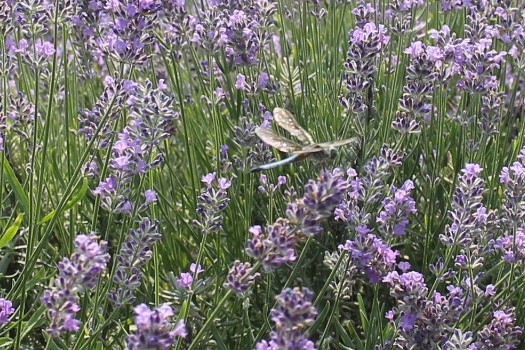Munstead Lavender - An Introduction
- wildwoodlavenderfa7
- 2 days ago
- 3 min read
Wildwood's very first lavender was Munstead. It was hard to choose as a brand-new grower, but we liked Munstead's variety of uses, color, prettiness and its hardiness in our growing zone (7b). The plants were delivered damaged, up-side-down and only about 10% survived. It was not the grower's fault, and they reimbursed us, offering a new shipment. I didn't trust the shipper and decided to travel to Canada with my dad to pick them up.
It was one of best trips with my dad, including crossing the border with 900 plants the first year and 1,200 the second year. The smell in the van was amazing, but my heart was racing while the border patrol ran off looking for the agriculture specialist to determine if our paperwork was legal. It was and the officers told us we were the first folks to cross with proper paperwork. They always had to throw away crossers' plants because they never had legal certification. We learned most plant shippers entered the US at another crossing that is more familiar with agriculture products (we went there our second year).
Now we grow our own plants by cuttings and sell to our customers & wholesalers. Next year, our original plants will be 10 years old.
Munstead's History
Munstead lavender (Lavandula angustifolia 'Munstead') is a compact and early blooming English lavender cultivar introduced in 1916. It was named after Munstead Woods in Surrey, England, the home of renowned garden designer Gertrude Jekyll, who favored this plant for its beauty and versatility[1][2][6].
Munstead is known for its heat and drought tolerance, making it ideal for USDA hardiness zones 5-9. It grows to about 12–18 inches tall and spreads up to 24 inches wide. Munstead's violet-blue flowers are highly fragrant, attracting pollinators such as bees and butterflies. Its culinary uses include flavoring baked goods, beverages, and jellies[2][3].
Historically, lavender has been cherished for over 2,500 years for its medicinal properties, aromatic qualities, and use in gardens. Munstead continues this legacy as a popular choice for aromatherapy and ornamental gardening[5][6].

PH Levels & Munstead
Typically, Munstead is a nice dark violet-blue color. But Wildwood's is a wide range from lighter pinks, violets, blues and darker blues. We thought it was genetics, but we learned PH affects Munstead much like it does hydrangeas.
Soil pH significantly affects the color of Munstead lavender blooms because it influences nutrient availability and plant health:
Optimal Range: Munstead lavender thrives in a neutral to slightly alkaline soil pH (6.5–7.5), which ensures proper nutrient absorption and vibrant flower colors[1][3].
Low pH (Acidic Soil): Acidic soil can limit nutrient availability, leading to paler or less vibrant blooms[7].
High pH (Excessively Alkaline Soil): Overly alkaline soil may "tie up" nutrients, potentially dulling flower colors and affecting overall plant health[3][5].
Maintaining the ideal pH range is key to achieving the characteristic vibrant purple hues of Munstead lavender.
We are working on testing our PH more and adding lime or wood ash to raise the PH. We have our soil professionally tested every third year, but we are testing it ourselves while we work on the Munstead rows. We do like how the mix of colors make beautiful wreaths, but testing one row to see how the color changes is a new challenge.
By ©2025 Shana King
Photos ©2022-2024 Bill and Shana King
Citations: History
[1] LAVANDULA ANGUSTIFOLIA Munstead - Everything Lavender https://everything-lavender.com/munstead-lavender.html
[2] Munstead Lavender Seeds - Botanical Interests https://www.botanicalinterests.com/products/munstead-lavender-seeds
[3] Lavandula angustifolia 'Munstead' - Twin Flame Lavender Farm https://twinflamelavender.farm/munstead-lavender-lavandula-angustifolia-munstead/
[4] The history of lavender | Country Life https://www.countrylife.co.uk/gardens/the-history-of-lavender-77616
[5] A History Of Lavender | High Country Gardens https://www.highcountrygardens.com/content/gardening/lavender-history
[6] Lavandula angustifolia 'Munstead' | Walters Gardens, Inc. https://www.waltersgardens.com/variety.php?ID=LAVMS
[7] Lavender: History, Taxonomy, and Production | NC State Extension https://newcropsorganics.ces.ncsu.edu/herb/lavender-history-taxonomy-and-production/
[8] Lavandula angustifolia - Wikipedia https://en.wikipedia.org/wiki/Lavandula_angustifolia
Citations: PH
[1] Top 4 Tips for Choosing Munstead Lavender Soil - Greg https://greg.app/munstead-lavender-soil/
[2] How to Grow and Care for Munstead Lavender - The Spruce https://www.thespruce.com/growing-munstead-lavender-5101145
[3] Lavender Demystified - Backbone Valley Nursery https://backbonevalleynursery.com/lavender-demystified/
[4] [PDF] Lavenders for Northern Gardens - Chicago Botanic Garden https://www.chicagobotanic.org/sites/default/files/pdf/plantevaluation/no42_lavender.pdf
[5] Growing Lavender in the North - Minnesota State Horticultural Society https://northerngardener.org/growing-lavender/
[6] Lavandula angustifolia 'Munstead' - Twin Flame Lavender Farm https://twinflamelavender.farm/munstead-lavender-lavandula-angustifolia-munstead/
[7] Are lavender blooms supposed to turn brown? - NYBG Mertz Library ... https://libanswers.nybg.org/faq/266901
[8] Lavandula angustifolia 'Munstead' (Lavender) - Gardenia.net https://www.gardenia.net/plant/lavandula-angustifolia-munstead-lavender






















Comments